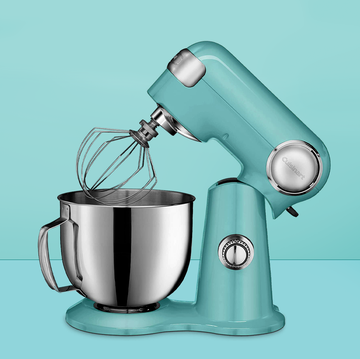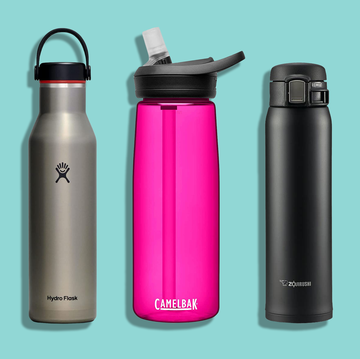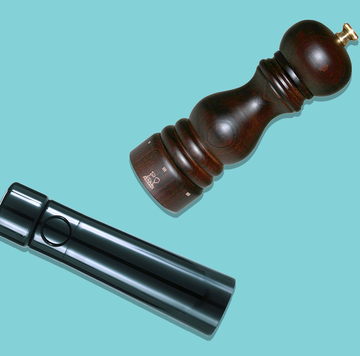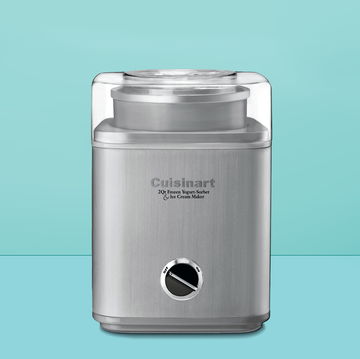We've been independently researching and testing products for over 120 years. If you buy through our links, we may earn a commission. Learn more about our review process.
8 Best Carbon Steel Skillets of 2022 for Every Home Cook
Our seasoned kitchen pros say there are plenty of reasons to add a carbon steel frying pan to your kitchen.

Carbon steel skillets, a mainstay in many restaurant kitchens, are now growing in popularity with home cooks. And with good reason: They're durable and versatile. They work with basically all cooktops, including induction; most are oven safe, and some are even designed for open-flame cooking, like on the grill or over a campfire.
So what is carbon steel? The simplest way to explain it is that it's like the best of stainless steel cookware and cast-iron cookware. It's lightweight and responsive to heat, like stainless steel, and it's long-lasting and can develop a naturally nonstick surface with seasoning, like cast iron. Properly seasoned carbon steel (read more on that below!) can last for decades and works well for both delicate and hearty foods.
The pros in the Good Housekeeping Institute Kitchen Appliances & Innovation Lab test all kinds of cookware, including stainless steel, cast iron, nonstick pans, ceramic cookware sets and Dutch ovens. To find the best carbon steel skillets, we tested 15 pans, cooking steak with a pan sauce and preparing eggs without oil or butter. We considered the shape and weight of the pan. We noted whether it arrived preseasoned, and we compared each pan's responsiveness to and distribution of heat.
Our top picks:
- 1
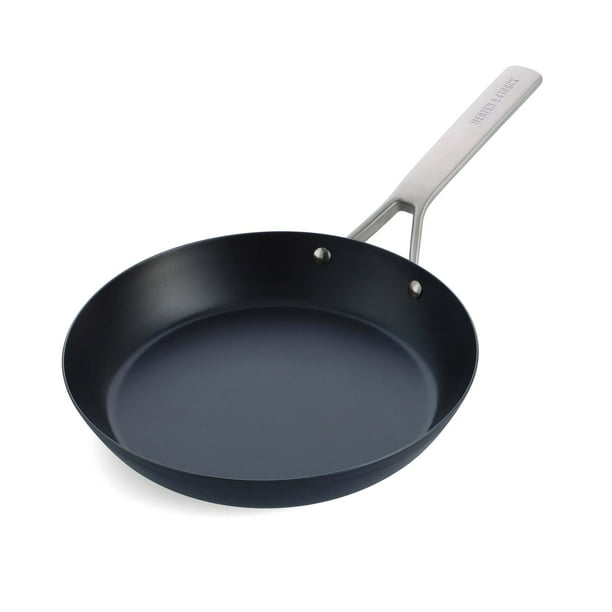
- 2
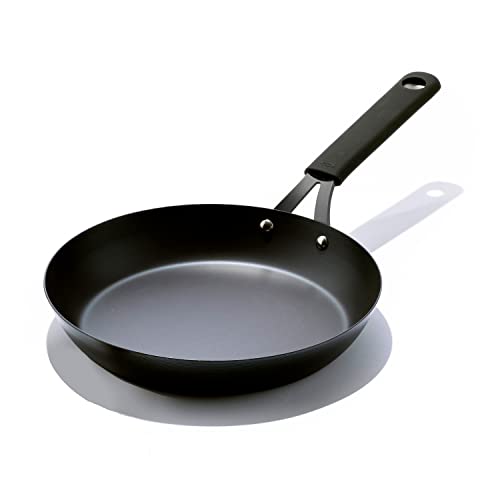
- 3

- 4
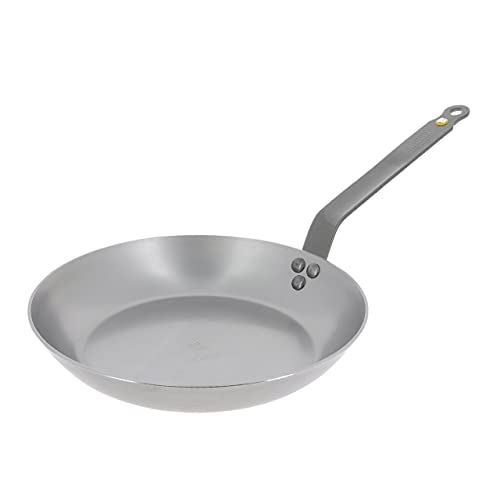
- 5

- 6
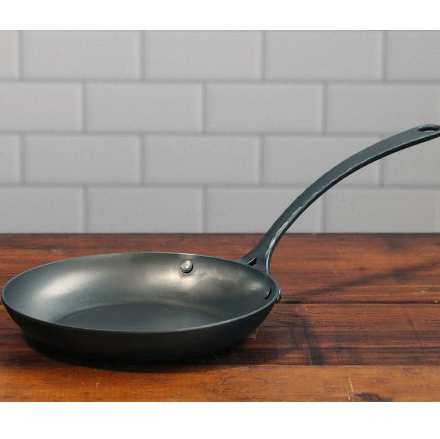
- 7

- 8
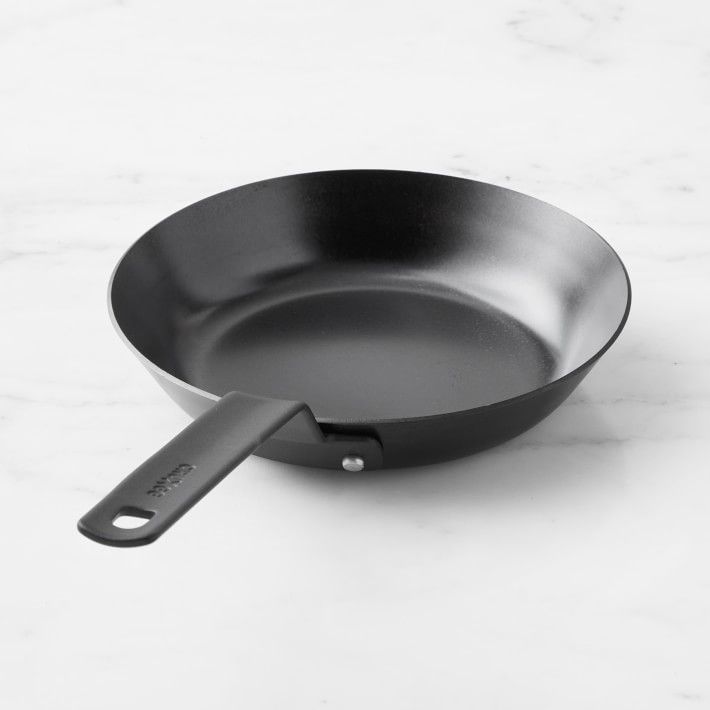
After our list, read below about how we tested these carbon steel skillets, what they're best for — even if you're cooking while camping — and what to consider when shopping for one. We also share advice on how to season and care for carbon steel, and provide even more in-depth information on what carbon steel is.
Merten & Storck Pre-Seasoned Carbon Steel Pro Skillet

Merten & Storck Pre-Seasoned Carbon Steel Pro Skillet
Pros
Lightweight with a roomy cooking area
Suitable for grill and open-flame cooking
Cons
No loop on handle for hanging storage
This pan performed well in our tests. Our pros like that it's preseasoned — just rinse off the protective glaze before you first cook — so it's ready to use right out of the gate. But it was the performance of this pan that earned it our top spot: It's lightweight, making it comfortable for most people to use, and has gently sloped sides that provide a nice cooking area and make shaking and tossing easy. It browned mushrooms well in our tests, creating a flavorful pan sauce. It struggled a little with eggs at first, but it improved over the course of the test (and while we don't use oil when testing, we feel confident that doing so will make this a good choice for eggs too). It's suitable for outdoor cooking on the grill — or even over an open flame. One downside is that the handle does not include a loop so you can hang the pan when not in use.
| Size | 10 inches |
|---|---|
| Weight | 2.5 pounds |
| Preseasoned | Yes |
| Oven-safe temperature | Up to 600˚F |
OXO Obsidian Pre-Seasoned Carbon Steel Skillet


OXO Obsidian Pre-Seasoned Carbon Steel Skillet
Pros
Removable silicone handle cover provides a comfortable grip
Suitable for use on the grill
Cons
If the handle cover isn't removed before cleaning, water can get trapped inside, leading to rusting
This was the most affordable pan in our tests. The accessible price makes it a great pick for those looking to add carbon steel to their kitchens. It comes preseasoned for ease but will give newbies a glimpse of the care needed to preserve that seasoning. We found it lightweight and easy to maneuver when making a pan sauce. It comes with a silicone sleeve for the handle that provides a more secure grip too, which we found necessary because the handle does get hot. One caveat: If the handle cover is not removed before washing, water can get trapped in the sleeve and lead to rust.
It's noteworthy that this skillet is part of OXO's Carbon Steel Obsidian Series, which includes a larger and smaller skillet (12 inches and eight inches) and a wok, as well as less common pieces, such as a crepe pan and a roaster with a rack. And the pieces are suitable for use on the grill.
| Size | 10 inches |
|---|---|
| Weight | 2.8 pounds |
| Preseasoned | Yes |
| Oven-safe temperature | Up to 660˚F |
Viking Culinary Blue Steel 10-Inch Fry Pan


Viking Culinary Blue Steel 10-Inch Fry Pan
Pros
Preseasoned finish makes it easy to get started and easy to maintain
Produced nice, even browning on steak
Cons
Cooking area in pan is small for some tasks
One of the winners of our Kitchen Gear Awards, this Viking skillet has a sleek, preseasoned finish that performed like a nonstick skillet from day one. It delivered excellent browning in our steak test, and our tester noted that the slightly arced handle added balance and control when lifting and shaking the lightweight pan. The smooth finish also made this pan easy to clean. Our caveat is that the cooking surface can feel a little cramped for some foods because the sloped sides create a smaller cooking area.
| Size | 10 inches |
|---|---|
| Weight | 2.75 pounds |
| Preseasoned | Yes |
| Oven-safe temperature | Up to 450˚F |
De Buyer Mineral B Carbon Steel Fry Pan

De Buyer Mineral B Carbon Steel Fry Pan
Pros
High scores in Lab tests for browning
Great care and seasoning instructions on the brand's website
Cons
While still manageable, it's the heaviest skillet on our list
French manufacturer de Buyer has been making products for nearly 200 years, and the brand has brought that extensive know-how to its carbon steel cookware. The Mineral B skillet earned high scores in our browning tests, delivering a nice sear on steak. Our tester found that the pan's sloped sides made it easy to shake when making a pan sauce, even though the skillet was one of the heavier in our tests. The angle of the handle also helped with maneuverability, because it helped create balance. We did note that the pan is recommended for oven use only up to 400˚F and for 10 minutes or less.
| Size | 10.25 inches |
|---|---|
| Weight | 4.19 pounds |
| Preseasoned | No |
| Oven-safe temperature | Up to 400˚F for 10 minutes |
Lodge Seasoned Carbon Steel Skillet

Lodge Seasoned Carbon Steel Skillet
Pros
Performed well with both steak and eggs
Can be used for stovetop, oven, grill and campfire cooking
Cons
Shallower sides than other skillets on our list
Lodge is best known for its reliable cast iron pans, and this carbon steel skillet is upholding the brand's reputation for quality cookware. The skillet is a steal at less than $40, given that it performed well across our Lab tests, comes preseasoned and is suitable for all cooktops, as well as for campfire cooking. This pan has shallower sides than others in our test, which does limit the volume the pan can hold and makes it more challenging to toss ingredients while cooking. But the long handle and sturdy design help it feel balanced for any shaking you might want do. Our tester noted that it produced a flavorful pan sauce quickly.
| Size | 10 inches |
|---|---|
| Weight | 3.12 pounds |
| Preseasoned | Yes |
| Oven-safe temperature | Not provided, but the brand claims it's safe for campfire cooking |
Blanc Creatives 9-Inch Pro Skillet

Blanc Creatives 9-Inch Pro Skillet
Pros
Performed well in Lab tests for cooking eggs
Handle design aids in control of the pan
Cons
Expensive
This American-made pan is a stunner: The gentle curves and elegant arc of the handle are eye-catching. And it got high scores in our egg tests. Even though it requires seasoning, it developed a smooth surface that released food nicely. Our tester also noted that the arc of the handle and the shape of the pan made it easy to shake and toss ingredients during cooking. Because Blanc Creatives doesn't offer a 10-inch pan, we tested the nine-inch skillet (the brand also offers an 11-inch version) and found that, even accounting for the smaller dimensions, this pan has a small cooking area. It was also somewhat heavy, coming in at a weight similar to that of the 10-inch skillets in our test. One unique feature: The rivets are a bit flatter than those on the other pans on our list. This makes it easier to clean and season the pan.
| Size | 9 inches |
|---|---|
| Weight | 3.32 pounds |
| Preseasoned | No |
| Oven-safe temperature | Not provided |
Sardel Carbon Steel 10-Inch Skillet

Sardel Carbon Steel 10-Inch Skillet
Pros
Nice, even browning on both sides of meat
Lightweight and easy to handle
Cons
Struggled a little with eggs (but they were cooked without oil for testing)
Sardel's carbon steel skillet is another winner of our Kitchen Gear Awards. It got perfect scores for browning steak, achieving a flavorful, even sear on both sides of the meat. The skillet was also easy to use: It's lightweight, and the handle has a slight channel that makes it easy to grip. Although the pan was in the middle of the pack in our egg tests with no oil, our tester was pleased with the release of the meat and believes the pan will handle delicate foods well as the seasoning develops.
| Size | 10 inches |
|---|---|
| Weight | 2.68 pounds |
| Preseasoned | No |
| Oven-safe temperature | Up to 500˚F |
CruxGG Seasoned Blue Steel Fry Pan

CruxGG Seasoned Blue Steel Fry Pan
Pros
High sides provide depth that's good for sauces and braises
Even browning in Lab tests
Cons
Handle can get warm during use
CruxGG is a collaboration between Crux and Ghetto Gastro, a Bronx-based collective of chefs dedicated to fighting food insecurity. This skillet got a perfect score in our pan sauce test, thanks to even browning on the steak and the mushrooms, as well as efficient simmering. The sides are tall, which means that the pan is deep enough for sauces, braises and stir-fries. It's preseasoned, so it's ready to cook with quickly. It was a mid-weight pan in our tests, but it felt easy to maneuver and secure and steady when sitting on the burner. Our tester did note that the handle got warm during use.
| Size | 10 inches |
|---|---|
| Weight | 3.09 pounds |
| Preseasoned | Yes |
| Oven-safe temperature | Up to 500˚F |
How we test carbon steel pans
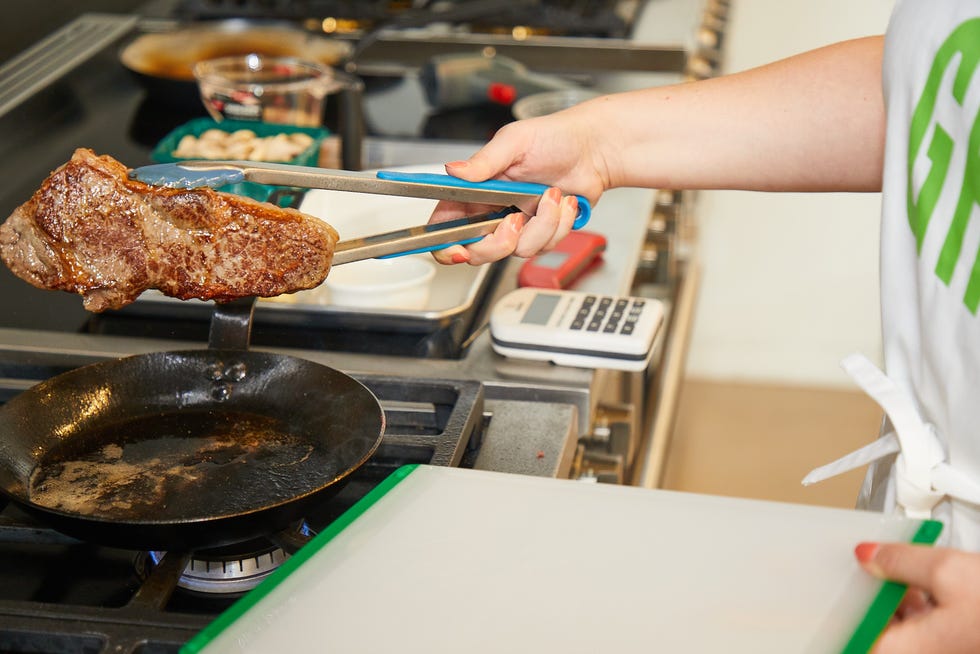
To test carbon steel skillets, the pros in the Good Housekeeping Institute Kitchen Appliances & Innovation Lab rounded up well-reviewed pans from new brands and brands we trust. We followed the manufacturer's instructions to season any pans that did not arrive preseasoned.
We then cooked about 90 pounds of steak, more than seven pounds of mushrooms and 75 eggs. Searing steak helps us determine how evenly the pan heats and whether it delivers uniform browning. Making a pan sauce demonstrates the skillet's ability to simmer, which indicates heat retention and responsiveness to changes in temperature as we adjust the heat; we also shake the mushrooms we include in the sauce to assess maneuverability. Cooking eggs — both sunny-side up and scrambled — helps us evaluate the pan's ability to release foods.
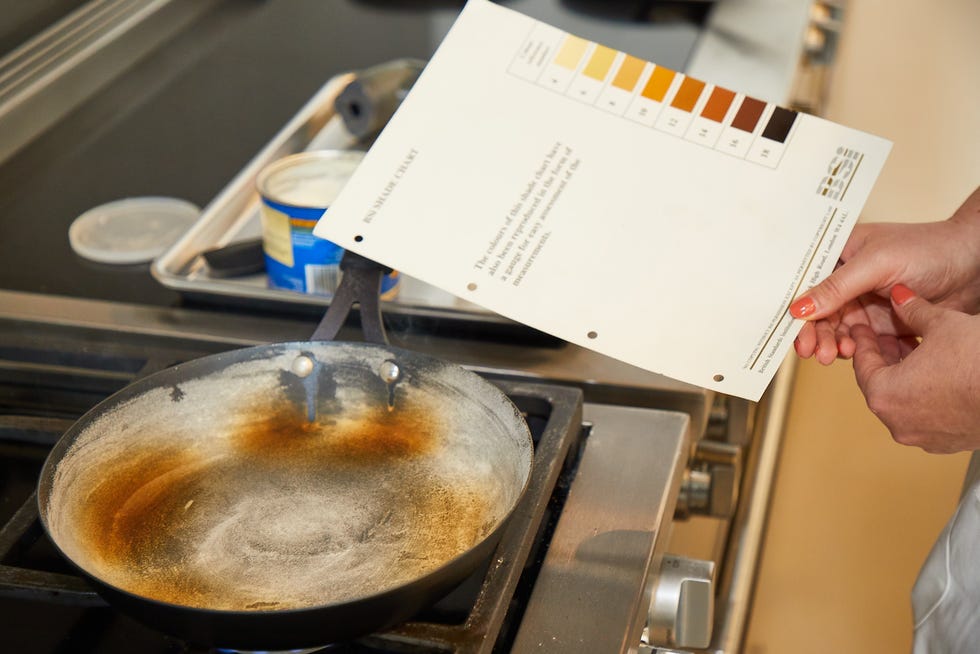
We weighed each pan and assessed its heat distribution and responsiveness by coating the skillet with shortening and a thin layer of flour and then heating the pan until the flour browns; the level of browning is then evaluated against a standardized chart. The pattern of the browning helps us determine hot spots in the pan and to see how evenly it distributes heat. We also noted whether the handle stayed cool and how easy the pan was to clean.
What to consider when shopping for a carbon steel skillet

You may have heard about blue carbon steel and black carbon steel and wondered if one is better. After our testing, we don't feel it should rank heavily as a consideration for purchase. Blue carbon steel has gone through a process that hardens the material, which can help prevent rust; that process can lend a blue hue to the brand-new pan. But both blue and black steel will take on a dark-brown or black color with proper seasoning during the life of the pan. We've recommended both blue and black steel pans here, as we saw good results from each kind.
Our experts do think these factors are worth considering when shopping for a carbon steel skillet:
✔️ Preseasoning: This is an important consideration if you're new to seasoning cookware. Preseasoned pans usually have a minor glaze to rinse off before cooking, but they're otherwise ready to go. They can feel like nonstick cookware for the first cook, and then they simply require maintenance of the seasoning (read: you will have to season a preseasoned carbon steel skillet over the course of its life). If it's not preseasoned, you'll likely need to scrub off a beeswax coating and then season the pan with layers of oil (see below). It's not a difficult process, but it does require time.
✔️ Weight: There are many lightweight carbon steel skillets on the market now, but our pros stress that it's still an important consideration. Some can be quite heavy, which can limit the pan's versatility. If you're shopping online and can't feel and lift the pan, check the weight in the product specifications. We like pans that are about three pounds or fewer.
✔️ Shape and cooking area: The shape of the pan will affect the cooking. A gentle slope to the sides makes it easier to shake and toss foods, and it keeps the pan open so that liquids will reduce easily. But sloped sides can eat into the flat cooking surface at the bottom of the pan. We've noted when pan on this list had a cooking surface that felt smaller, but some is up to personal preference and the kinds of foods you cook most.
✔️ Handle: Comfort with the handle is another factor that comes down to personal preference. Our experts liked a variety of handles in our tests. Those with a divot in the handle helped with finger placement for comfort. Those with a slight arc or angle helped create balance, which can help improve control. Look for a loop built into the handle if you prefer to hang your pans for storage.
✔️ Rivets: Generally speaking, the handles of carbon steel skillets are riveted to the pan, such that there are bumps on the inside of the cooking area. In our tests, we saw only one with flush rivets (the Matfer Bourgeat Black Steel Frying Pan, which did not make our list) and one that had somewhat flat rivets (the Blanc Creatives Pro Skillet, listed above). Flush or flatter rivets make it easier to clean the pan, as debris is less likely to get stuck, and easier to season it, as you can access the surface more evenly.
What cooks best in a carbon steel skillet?

Carbon steel skillets are great for searing foods like steak, pork chops and chicken thighs, because they're good at high-heat cooking. But you'll want to start the pan over medium-low or medium heat and then gradually crank it up, because it helps distribute the heat evenly and prevent warping.
And thanks to its smooth surface and ability to become more seasoned and naturally nonstick over time, carbon steel is also a good choice for more delicate foods like eggs, pancakes and even fish.
Because most carbon steel pans are oven safe, they're also good for searing and then roasting foods (like pork or beef tenderloin), roasting potatoes and other veggies, and baking cornbread or biscuits.
Like cast iron, carbon steel isn't the best choice for simmering acidic sauces like marinara, because it might strip away some of the natural seasoning.
What is carbon steel? A closer look

Honestly, the name is a little misleading, since all steel contains carbon. The performance of this material comes down to the amount of carbon and the alloy content. Sounds dull, but stick with me for a second. Let's compare carbon steel to cookware that's more familiar: stainless steel and cast iron.
Stainless steel cookware contains more of the alloy chromium, and the reason that matters for you is that it protects stainless steel from corrosion. Carbon steel has less chromium, so it can rust and needs to be seasoned. But the two materials are similar in that they are lightweight and responsive to heat. Again, this matters to you because responsiveness lets you control the pan when you want to drop a boil to a simmer or to avoid burning something you're searing.
In contrast, cast iron cookware contains a little more carbon than carbon steel (2% to 3%, compared with carbon steel's 1%), and this matters because it makes cast iron more brittle, meaning it must be cast (poured into a mold, hence the name), giving it a rougher texture. The relative flexibility of carbon steel allows it to be stamped (pressed into shape from a single sheet), which gives it a smoother surface.
The smooth surface makes carbon steel easy to cook with, and the ability to build up a seasoned surface is what makes these pans more naturally nonstick over time.
How do you season a carbon steel skillet?

Some carbon steel pans are sold preseasoned, meaning you can cook with them right away. Others will need to be seasoned before they're ready for use. Seasoning is the process of using oil to build up a natural patina that functions as a nonstick coating. Here's how to season and care for your carbon steel pans:
✔️ Seasoning:
- Wash and dry the pan. Many unseasoned carbon steel skillets will come sealed in a beeswax coating that prevents the pan from rusting in transit. Use hot water, a gentle dish soap and a sponge or gentle dishcloth to wash the pan until the waxy coating is removed. Dry the pan thoroughly.
- Follow the manufacturer's instructions for seasoning. But most will be similar to this: Add a small amount of a cooking oil, like vegetable or canola, to the pan. Use a paper towel or dishtowel to spread the oil across the bottom and up the sides of the pan until it is barely shiny and mostly absorbed.
- Place the pan over the heat level recommended by the manufacturer, and heat until the oil just begins to smoke. Remove the pan from the heat and, using tongs to protect your hand, use a clean paper towel or dishtowel to wipe any oil around the pan so that it's no longer visible. Let the pan cool completely.
- Repeat step three as many times as the manufacturer indicates, often two to four more times. Let the pan cool completely.
The pan is now ready to use, though you will need to repeat this process over the life of the pan as needed. Cooking fatty food is a great way to season the pan as you use it. Note that the pan may look splotchy or streaky and will become darker as the season process progresses. This is normal. Even blue steel pans will become black over time.
✔️ Care:
Your goal is simple: Protect your lovingly applied seasoning and prevent rust. In a nutshell:
- Do not put carbon steel in the dishwasher. The cycle (especially if you use today's grease-fighting detergents) will likely strip away the seasoning, and it may keep the pan wet long enough for rust to develop on the exposed material.
- Do not soak your carbon steel, and wash it gently. Basically, water is the enemy when caring for your pan. Wash it right after cooking, or set it aside to address later, but don't leave it in the sink or on the stove full of water. Often, you'll need only to rinse your pan. You can scrape up bits with a wooden spoon or a gentle sponge. You can use gentle dish soap as needed. But you don't want to scrub with harsh cleansers or stiff bristles.
- Dry the pan thoroughly immediately after washing. You can dry with a dishtowel or with a quick trip over low heat, as long as the moisture is eliminated.
Why trust Good Housekeeping?

Senior Editor & Analyst Sarah Wharton helped craft the methodology for testing carbon steel pans and led the testing for this story. She has been using carbon steel pans at home — seared scallops are a fave — for years now. She is a graduate of the International Culinary Center (now the Institute of Culinary Education) and has been cooking professionally since 2017. She has written about nonstick cookware and the best saucepans for the Good Housekeeping Institute.

Sarah (she/her) is a deputy editor for the Good Housekeeping Institute, where she tests products and covers the best picks across kitchen, tech, health and food. She has been cooking professionally since 2017 and has tested kitchen appliances and gear for Family Circle as well as developed recipes and food content for Simply Recipes, Martha Stewart Omnimedia, Oxo and Food52. She holds a certificate in professional culinary arts from the International Culinary Center (now the Institute of Culinary Education).
Watch Next


10 Best Lunch Bags for Adults
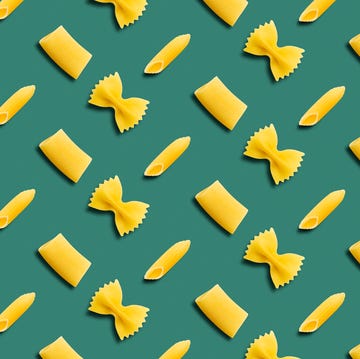
12 Best Low-Carb Noodles of 2023

4 Best Knife Sharpeners, According to Pros

How to Easily Clean and Descale Your Keurig
